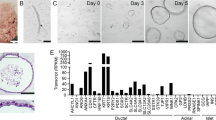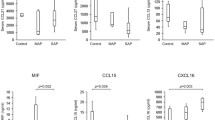Abstract
Recently, there has been a great deal of interest in the role of cytokines in acute pancreatitis. Serum levels of IL-1, IL-6, and TNF-α have been demonstrated to be elevated in acute pancreatitis. We hypothesized that cytokines may be produced primarily by pancreatic parenchymal cells. Reasoning that ductal epithelium is the cell type most likely to be exposed to noxious stimuli in common causes of pancreatitis, such as ERCP and passage of a gallstone, we examined the response of well differentiated pancreatic ductal adenocarcinoma cell lines to stimuli known to stimulate cytokine production in other cells. CAPAN-1 and CAPAN-2 cells were incubated with endotoxin or TNF-α. The supernatant was assayed for production of IL-1, IL-6, and IL-8 by ELISA. The cells were assayed for activation of the transcription factor NF-κB by electrophoretic mobility shift assay. There was no detectable production of IL-1 by either cell line. CAPAN-1 cells had concentration-dependent production of IL-6 and IL-8 in response to both endotoxin and TNF-α. CAPAN-2 cells had concentration-dependent production of IL-6 and IL-8 in response to TNF-α. They had low level expression of IL-8 that was unaffected by any concentration of LPS, and no detectable production of IL-6 in response to LPS. These findings suggest that pancreatic duct cells may take an active part in the pathogenesis of acute pancreatitis through the production of cytokines.
Similar content being viewed by others
REFERENCES
Le J, Vilcek J: Biology of disease: Tumor necrosis factor and interleukin-1: cytokines with multiple overlapping biological activities. Lab Invest 56:234-248, 1987
Dinarello CA: Biology of interleukin 1 FASEB J 2:108-115, 1988
Watters JM, Bessey PQ, Dinarello CA, et al: The induction of interleukin 1 in humans and its metabolic effects. Surgery 98:298-306, 1985
DeForge LE, Nguyen DT, Kunkel SL, Remick DG: Regulation of the pathophysiology of tumor necrosis factor. J Lab Clin Med 116:429-438, 1990
Jaattela M: Biology of disease: Biologic activities and mechanisms of action of tumor necrosis factor-α/cachectin. Lab Invest 64:724-740, 1991
Kishimoto T: The biology of interleukin 6. Blood 74:1-10, 1989
Bauer J, Herrman F: Interleukin 6 in clinical medicine. Ann Hematol 62:203-210, 1991
Le J, Vilcek J: Biology of disease: Interleukin 6: A multifunctional cytokine regulating immune reactions and the acute phase protein response. In Pathology Reviews. E Rubin, I Damjanov (eds). Humana Press, Clifton, New Jersey, 1990, pp 97-111
Mukaida N, Matsushima K: Regulation of IL-8 production and the characteristics of the receptors for IL-8. Cytokines 4:41-53, 1992
Baggiolini M, Clark-Lewis I: Interleukin 8, a chemotactic and inflammatory cytokine. Fed Eur Biochem Soc 307:97-101, 1992
Baggiolini M, Walz A, Kunkel SL: Neutrophil activating peptide 1/interleukin 8, a novel cytokine that activates neutrophils. J Clin Invest 84:1045-1049, 1989
Exley AR, Leese T, Holliday MP, Swann RA, Cohen J: Endotoxaemia and serum tumour necrosis factor as prognostic markers in severe acute pancreatitis. Gut 33:1126-1128, 1992
Banks RE, Evans SW, Alexander D, McMahon MJ, Whicher JT: Is fatal pancreatitis a consequence of excessive leukocyte stimulation? The role of tumor necrosis factor a. Cytokine 3:12-16, 1991
de Beaux AC, Goldie AS, Ross JA, Carter DC, Fearon KC: Serum concentrations of inflammatory mediators related to organ failure in patients with acute pancreatitis. Br J Surg 83:349-353, 1996
McKay CJ, Gallagher G, Brooks B, Imrie CW, Baxter JN: Increased monocyte cytokine production in association with systemic complications in acute pancreatitis. Br J Surg 83:919-923, 1996
Manes G, Spada OA, Rabitti PG, Pacelli L, Iannaccone L, Uomo G: Serum interleukin-6 in acute pancreatitis due to common bile duct stones. A reliable marker of necrosis. Recenti Prog Med 88:69-72, 1997
Inagaki T, Hoshino M, Hayakawa T, Ohara H, et al: Interleukin 6 is a useful marker for early prediction of the severity of acute pancreatitis. Pancreas 14:1-8, 1997
Leser HG, Gross V, Scheibenbogen C, Heinisch A, et al: Elevation of serum interleukin-6 concentration precedes acutephase response and reflects severity in acute pancreatitis. Gastroenterology 101:782-785, 1991
Pezzilli R, Billi P, Miniero R, Fiocchi M, et al: Serum interleukin-6, interleukin-8, and beta 2-microglobulin in early assessment of severity of acute pancreatitis. Comparison with serum C reactive protein. Dig Dis Sci 40:2341-2348, 1995
Vieira-Coelho MA, Soares-Da Silva P: Uptake and intracellular fate of L-DOPA in a human intestinal epithelial cell line: Caco-2. Am J Physiol 275:C104-C112, 1998
Mailleau C, Capeau J, Brahimi-Horn MC: Interrelationship between the Na1/glucose cotransporter and CFTR in Caco-2 cells: Relevance to cystic fibrosis.
Trapote MA, Clemente F, Galera C, Morales M, et al: Inositolphosphoglycans are possible mediators of the glucagon-like peptide 1 (7-36) amide action in the liver. J Endocrinol Invest 19:114-118, 1996
Almog Y, Klein A, Adler R, Laub O, Tur-Kaspa R: Estrogen suppresses hepatitis B virus expression in male athymic mice transplanted with HBV transfected Hep G-2 cells. Antiviral Res 19:285-293, 1992
Becq F, Hollande E, Gola M: Phosphorylation-regulated lowconductance Cl- channels in a human pancreatic duct cell line. Pfleugers Arch 425:1-8, 1993
Becq F, Fanjul M, Merten M, Figarella C, Hollande E, Gola M: Possible regulation of CFTR-chloride channels by membrane-bound phosphatases in pancreatic duct cells. FEBS Lett 327:337-342, 1993
Sen R, Baltimore D: Multiple nuclear factors interact with the immunoglobulin enhancer sequences. Cell 46:705-716, 1986
Dignam JD, Lebovitz RM, Roeder RG: Accurate transcription initiation of RNA polymerase II in a soluble extract from isolated mammalian nuclei. Nucleic Acids Res 11:1475-1489, 1983
Gukovskaya AS, Gukovsky I, Zaninovic V, Song M, Sandoval D, Gukovsky S, Pandol SJ: Pancreatic acinar cells produce, release, and respond to tumor necrosis factor-alpha. Role in regulating cell death and pancreatitis. J Clin Invest 100:1853-1862, 1997
Author information
Authors and Affiliations
Rights and permissions
About this article
Cite this article
Blanchard, J.A., Barve, S., Joshi-Barve, S. et al. Cytokine Production by CAPAN-1 and CAPAN-2 Cell Lines. Dig Dis Sci 45, 927–932 (2000). https://doi.org/10.1023/A:1005573024448
Issue Date:
DOI: https://doi.org/10.1023/A:1005573024448




